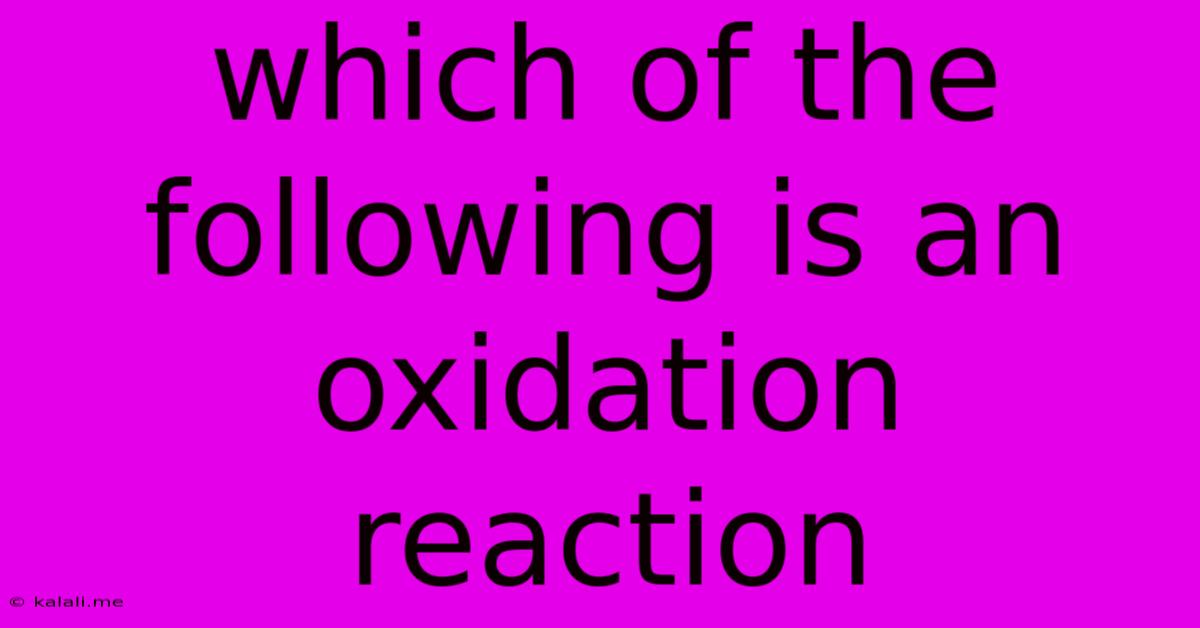Which Of The Following Is An Oxidation Reaction
Kalali
Jun 13, 2025 · 3 min read

Table of Contents
Which of the Following is an Oxidation Reaction? Understanding Redox Reactions
This article will explore the concept of oxidation reactions, a fundamental concept in chemistry. We'll define oxidation, differentiate it from reduction, and delve into examples to help you confidently identify oxidation reactions. Understanding redox reactions (reduction-oxidation reactions) is crucial in various fields, from understanding metabolic processes in biology to designing efficient batteries in engineering.
What is an Oxidation Reaction?
Oxidation, in its simplest form, is the loss of electrons by a molecule, atom, or ion. This often involves an increase in oxidation state. Remember the mnemonic device OIL RIG – Oxidation Is Loss, Reduction Is Gain (of electrons). We often see oxidation reactions coupled with reduction reactions, creating a redox reaction.
Identifying Oxidation Reactions: Key Indicators
Several indicators can help you identify an oxidation reaction:
-
Increase in Oxidation State: This is the most fundamental indicator. The oxidation state, or oxidation number, reflects the number of electrons an atom has gained or lost. An increase signifies oxidation. Calculating oxidation states requires understanding rules for assigning them, which is beyond the scope of this article, but readily available in chemistry textbooks and online resources.
-
Loss of Hydrogen: Many organic oxidation reactions involve the loss of hydrogen atoms. For example, the oxidation of an alcohol to an aldehyde or ketone involves the loss of hydrogen.
-
Gain of Oxygen: Another common indicator is the addition of oxygen atoms to a molecule. The classic example is the rusting of iron (oxidation of iron), where oxygen reacts with iron to form iron oxide (rust).
-
Presence of an Oxidizing Agent: Oxidation reactions always involve an oxidizing agent – a substance that causes oxidation by accepting electrons. Common oxidizing agents include oxygen (O₂), potassium permanganate (KMnO₄), and potassium dichromate (K₂Cr₂O₇).
Examples of Oxidation Reactions
Let's look at some examples to solidify our understanding:
1. Rusting of Iron:
4Fe(s) + 3O₂(g) → 2Fe₂O₃(s)
Iron (Fe) loses electrons and its oxidation state increases, while oxygen (O₂) gains electrons and its oxidation state decreases. This is a classic example of a redox reaction where the iron is oxidized.
2. Combustion of Methane:
CH₄(g) + 2O₂(g) → CO₂(g) + 2H₂O(g)
Methane (CH₄) is oxidized, losing hydrogen atoms and gaining oxygen atoms. Oxygen acts as the oxidizing agent.
3. Oxidation of Ethanol to Ethanal:
CH₃CH₂OH → CH₃CHO + H₂
Ethanol loses hydrogen atoms (and electrons) converting to ethanal. This is an example of oxidation where hydrogen loss is the primary indicator.
Which Reaction is Oxidation? (Hypothetical Example)
Let's consider a hypothetical scenario where you are given a list of reactions. To determine which is an oxidation reaction, you would need to analyze each reaction for the key indicators mentioned above. Look for an increase in oxidation state, loss of hydrogen, gain of oxygen, or the presence of a known oxidizing agent. The reaction showing any of these indicators would be classified as an oxidation reaction.
Conclusion
Understanding oxidation reactions is a cornerstone of chemistry. By looking for key indicators like the increase in oxidation state, loss of hydrogen, gain of oxygen, and the presence of an oxidizing agent, you can accurately identify oxidation reactions within a broader context of redox chemistry. Remember, practice is key! Working through more examples will further solidify your understanding.
Latest Posts
Latest Posts
-
Match The Types Of Resources With Their Descriptions
Jun 14, 2025
-
Which Of The Following Is Colloid
Jun 14, 2025
-
What Is The Sum Of The First 10 Prime Numbers
Jun 14, 2025
-
What Organelle Gets Rid Of Waste
Jun 14, 2025
-
Router Operate At Which Layer Of The Osi Model
Jun 14, 2025
Related Post
Thank you for visiting our website which covers about Which Of The Following Is An Oxidation Reaction . We hope the information provided has been useful to you. Feel free to contact us if you have any questions or need further assistance. See you next time and don't miss to bookmark.